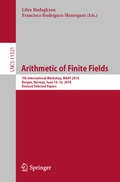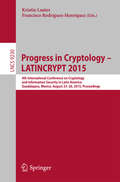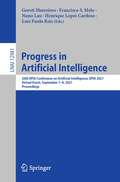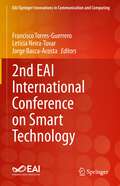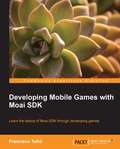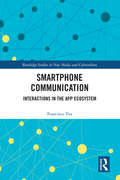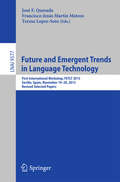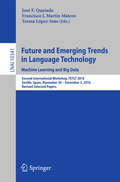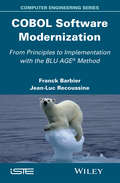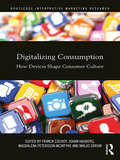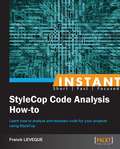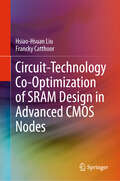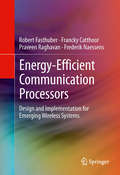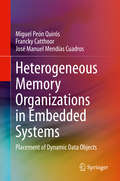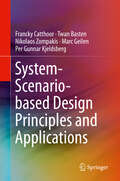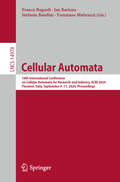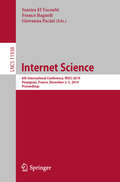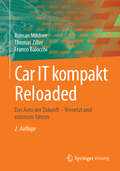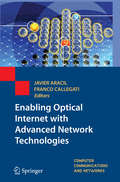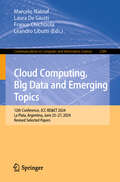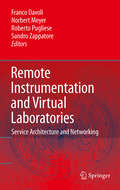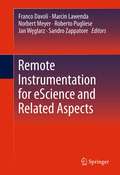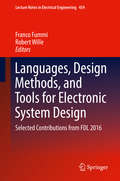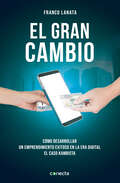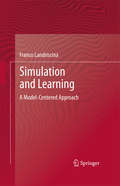- Table View
- List View
Arithmetic of Finite Fields: 7th International Workshop, WAIFI 2018, Bergen, Norway, June 14-16, 2018, Revised Selected Papers (Lecture Notes in Computer Science #11321)
by Lilya Budaghyan Francisco Rodríguez-HenríquezThis book constitutes the thoroughly refereed post-workshop proceedings of the 7th International Workshop on the Arithmetic of Finite Field, WAIFI 2018, held in Bergen, Norway, in June 2018. The 14 revised full papers and six invited talks presented were carefully reviewed and selected from 26 submissions. The papers are organized in topical sections on invited talks; elliptic curves; hardware implementations; arithmetic and applications of finite fields and cryptography.
Progress in Cryptology -- LATINCRYPT 2015
by Kristin Lauter Francisco Rodríguez-HenríquezThis book constitutes the proceedings of the 4th International Conference on Cryptology and Information Security in Latin America, LatinCrypt 2015, held in Guadalajara, Mexico, in August 2015. The 20 papers presented were carefully reviewed and selected from 49 submissions. They were organized in topical sections named: cryptographic protocols; foundations; post-quantum cryptography; symmetric key cryptanalysis; we still love pairings; curves in cryptography; and cryptographic engineering.
Progress in Artificial Intelligence: 20th EPIA Conference on Artificial Intelligence, EPIA 2021, Virtual Event, September 7–9, 2021, Proceedings (Lecture Notes in Computer Science #12981)
by Luís Paulo Reis Goreti Marreiros Henrique Lopes Cardoso Nuno Lau Francisco S. MeloThis book constitutes the refereed proceedings of the 20th EPIA Conference on Artificial Intelligence, EPIA 2021, held virtually in September 2021.The 62 full papers and 6 short papers presented were carefully reviewed and selected from a total of 108 submissions. The papers are organized in the following topical sections: artificial intelligence and IoT in agriculture; artificial intelligence and law; artificial intelligence in medicine; artificial intelligence in power and energy systems; artificial intelligence in transportation systems; artificial life and evolutionary algorithms; ambient intelligence and affective environments; general AI; intelligent robotics; knowledge discovery and business intelligence; multi-agent systems: theory and applications; and text mining and applications.
2nd EAI International Conference on Smart Technology (EAI/Springer Innovations in Communication and Computing)
by Leticia Neira-Tovar Francisco Torres-Guerrero Jorge Bacca-AcostaThis book presents the proceedings of 2nd EAI International Conference on Smart Technology (MTYMEX), which took place April 27th, 2021, online and in Monterrey, Mexico. MTYMEX is an international conference aimed at demonstrating the potential of new applications for the Internet in the future. The authors offer perspectives on research on smart technologies in society, including the results of research projects on virtual reality, blockchain, artificial intelligence, and smart cities. The book offers examples of applications with smart technologies in different knowledge areas. The conference brings together the academic, research and private sectors working on applications and smart devices for e-health and smart cities.
Developing Mobile Games with Moai SDK
by Francisco TufroA normal step-by-step tutorial with two sample games built in, to teach Moai SDK from scratch.This book is for anyone who wants to build games, especially if they want to quickly iterate using a scripting language like Lua, and they're targeting more than one platform. All of this without having to spend your salary on licenses. Moai SDK is aimed to professionals, but it has a great community that will help you learn and be a part of it.
Smartphone Communication: Interactions in the App Ecosystem (Routledge Studies in New Media and Cyberculture)
by Francisco YusThis book offers a unique model for understanding the cognitive underpinnings, interactions and discursive effects of our evolving use of smartphones in everyday app-mediated communication, from text messages and GIFs to images, video and social media apps. Adopting a cyberpragmatics framework, grounded in cognitive pragmatics and relevance theory, it gives attention to how both the particular interfaces of different apps and users’ personal attributes influence the contexts and uses of smartphone communication. The communication of emotions – in addition to primarily linguistic content – is foregrounded as an essential element of the kinds of ever-present paralinguistic and phatic communication that characterises our exchange of memes, GIFs, "likes," and image- and video-based content. Insights from related disciplines such as media studies and sociology are incorporated as the author unpacks the timeliest questions of our digitally mediated age. Aimed primarily at scholars and graduate students of communication, linguistics, pragmatics, media studies, and sociology of mass media, Smartphone Communication traffics in topics that will likewise engage upper-level undergraduate students.
Future and Emergent Trends in Language Technology
by José F. Quesada Francisco-Jesús Martín Mateos Teresa Lopez-SotoThis book constitutes the thoroughly refereed post-conference proceedings of the First International Workshop on Future and Emergent Trends in Language Technology, FETLT 2015, held in Seville, Spain, in November 2015. The 10 full papers presented together with 3 position papers and 7 invited keynote abstracts were selected from numerous submissions. The structure of the Workshop will feature a significant number of experts in language technologies and convergent areas. One objective will be the organization of forum sessions in order to review some of the current-trend research projects that are already addressing new methodological approaches and proposing solutions and innovative applications. A second major objective will be brainstorming sessions where representatives of the most innovative industrial sector in this area can present and describe the challenges and socio-economic needs of the present and immediate future. All researchers are invited to submit proposals that incorporate solid research and innovation ideas in the field of language technology and in connection with other convergent areas.
Future and Emerging Trends in Language Technology. Machine Learning and Big Data: Second International Workshop, FETLT 2016, Seville, Spain, November 30 –December 2, 2016, Revised Selected Papers (Lecture Notes in Computer Science #10341)
by Francisco-Jesús Martín Mateos José F Quesada Teresa López SotoThis book constitutes revised selected papers from the Second International Workshop on Future and Emerging Trends in Language Technology, FETLT 2016, which took place in Seville, Spain, in November 2016. The 10 full papers and 5 position papers presented in this volume were carefully reviewed and selected from 18 submissions. In 2016 the conference focused on Machine Learning and Big Data.
COBOL Software Modernization
by Jean-Luc Recoussine Franck BarbierNowadays, billions of lines of code are in the COBOL programming language. This book is an analysis, a diagnosis, a strategy, a MDD method and a tool to transform legacy COBOL into modernized applications that comply with Internet computing, Service-Oriented Architecture (SOA) and the Cloud. It serves as a blueprint for those in charge of finding solutions to this considerable challenge.
Digitalizing Consumption: How devices shape consumer culture (Routledge Interpretive Marketing Research)
by Franck Cochoy Johan Hagberg Magdalena Petersson McIntyre Niklas SörumContemporary consumer society is increasingly saturated by digital technology, and the devices that deliver this are increasingly transforming consumption patterns. Social media, smartphones, mobile apps and digital retailing merge with traditional consumption spheres, supported by digital devices which further encourage consumers to communicate and influence other consumers to consume. Through a wide range of empirical studies which analyse the impact of digital devices, this volume explores the digitization of consumption and shows how consumer culture and consumption practices are fundamentally intertwined and mediated by digital devices. Exploring the development of new consumer cultures, leading international scholars from sociology, marketing and ethnology examine the effects on practices of consumption and marketing, through topics including big data, digital traces, streaming services, wearables, and social media’s impact on ethical consumption. Digitalizing Consumption makes an important contribution to practice-based approaches to consumption, particularly the use of market devices in consumers’ everyday consumer life, and will be of interest to scholars of marketing, cultural studies, consumer research, organization and management.
Instant StyleCop Code Analysis How-to
by Franck LevequeFilled with practical, step-by-step instructions and clear explanations for the most important and useful tasks.The book will take a how-to approach, focusing on recipes that demonstrate Stylecop code analysis.Stylecop Code Analysis How-to is intended for developers and project managers who are looking for an all-encompassing overview of Stylecop to display or enforce their specific coding conventions. It is assumed that you have a minimal understanding of integration technologies such as MSBuild and Nant. You should also have some knowledge on how to program in C# and LINQ. An available version of Visual Studio 2008 professional or superior is also required to follow the first chapters of this book.
Circuit-Technology Co-Optimization of SRAM Design in Advanced CMOS Nodes
by Francky Catthoor Hsiao-Hsuan LiuModern computing engines—CPUs, GPUs, and NPUs—require extensive SRAM for cache designs, driven by the increasing demand for higher density, performance, and energy efficiency. This book delves into two primary areas within ultra-scaled technology nodes: (1) advancing SRAM bitcell scaling and (2) exploring innovative subarray designs to enhance power-performance-area (PPA) metrics across technology nodes. The first part of the book utilizes a bottom-up design-technology co-optimization (DTCO) approach, employing a dedicated PPA simulation framework to evaluate and identify the most promising strategies for SRAM bitcell scaling. It offers a comprehensive examination of SRAM bitcell scaling beyond 1 nm node, outlining a structured research cycle that includes identifying scaling bottlenecks, developing cutting-edge architectures with complementary field-effect transistor (CFET) technology, and addressing challenges such as process integration and routing complexities. Additionally, this book introduces a novel write margin methodology to better address the risks of write failures in resistance-dominated nodes. This methodology accounts for time-dependent parasitic bitline effects and incorporates timing setup of write-assist techniques to prevent underestimating the yield loss. In the second part, the focus shifts to a top-down DTCO approach due to the diminishing returns of bitcell scaling beyond 5 Å node at the macro level. As technology scales, increasing resistance and capacitance (RC) lead designers to adopt smaller subarray sizes to reduce effective RC and enhance subarray-level PPA. However, this approach can result in increased inter-subarray interconnect overhead, potentially offsetting macro-level improvements. This book examines the effects of various subarray sizes on macro-level PPA and finds that larger subarrays can significantly reduce interconnect overhead and improve the energy-delay-area product (EDAP) of SRAM macro. The introduction of the active interconnect (AIC) concept enables the use of larger subarray sizes, while integrating carbon nanotube FET as back-end-of-line compatible devices results in macro-level EDAP improvements of up to 65% when transitioning from standard subarrays to AIC divided subarrays. These findings highlight the future trajectory of SRAM subarray design in deeply scaled nodes.
Energy-Efficient Communication Processors
by Francky Catthoor Praveen Raghavan Frederik Naessens Robert FasthuberThis book describes a new design approach for energy-efficient, Domain-Specific Instruction set Processor (DSIP) architectures for the wireless baseband domain. The innovative techniques presented enable co-design of algorithms, architectures and technology, for efficient implementation of the most advanced technologies. To demonstrate the feasibility of the author's design approach, case studies are included for crucial functionality of advanced wireless systems with increased computational performance, flexibility and reusability. Designers using this approach will benefit from reduced development/product costs and greater scalability to future process technology nodes.
Heterogeneous Memory Organizations in Embedded Systems: Placement of Dynamic Data Objects
by Francky Catthoor Miguel Peón Quirós José Manuel Mendías CuadrosThis book defines and explores the problem of placing the instances of dynamic data types on the components of the heterogeneous memory organization of an embedded system, with the final goal of reducing energy consumption and improving performance. It is one of the first to cover the problem of placement for dynamic data objects on embedded systems with heterogeneous memory architectures, presenting a complete methodology that can be easily adapted to real cases and work flows. The authors discuss how to improve system performance and energy consumption simultaneously.Discusses the problem of placement for dynamic data objects on embedded systems with heterogeneous memory architectures;Presents a complete methodology that can be adapted easily to real cases and work flows;Offers hints on how to improve system performance and energy consumption simultaneously.
System-Scenario-based Design Principles and Applications
by Francky Catthoor Twan Basten Nikolaos Zompakis Marc Geilen Per Gunnar KjeldsbergThis book introduces a generic and systematic design-time/run-time methodology for handling the dynamic nature of modern embedded systems, without adding large safety margins in the design. The techniques introduced can be utilized on top of most existing static mapping methodologies to deal effectively with dynamism and to increase drastically their efficiency. This methodology is based on the concept of system scenarios, which group system behaviors that are similar from a multi-dimensional cost perspective, such as resource requirements, delay, and energy consumption. Readers will be enabled to design systems capable to adapt to current inputs, improving system quality and/or reducing cost, possibly learning on-the-fly during execution.Provides an effective solution to deal with dynamic system designIncludes a broad survey of the state-of-the-art approaches in this domainEnables readers to design for substantial cost improvements (e.g. energy reductions), by exploiting system scenariosDemonstrates how the methodology has been applied effectively on various, real design problems in the embedded system context
Cellular Automata: 16th International Conference on Cellular Automata for Research and Industry, ACRI 2024, Florence, Italy, September 9–11, 2024, Proceedings (Lecture Notes in Computer Science #14978)
by Jan Baetens Franco Bagnoli Stefania Bandini Tommaso MatteuzziThis book constitutes the refereed proceedings of the 16th International Conference on Cellular Automata for Research and Industry, Cellular Automata, ACRI 2024, held in Florence, Italy, in September 9–11, 2024. The 20 full papers presented were carefully reviewed and selected from 33 submissions. They were organized in the following topical sections: theory, mathematical and physical models; computational aspects and applications; social and biological models.
Internet Science: 6th International Conference, INSCI 2019, Perpignan, France, December 2–5, 2019, Proceedings (Lecture Notes in Computer Science #11938)
by Franco Bagnoli Giovanna Pacini Samira El YacoubiThis book constitutes the proceedings of the 6th International Conference on Internet Science held in Perpignan, France, in December 2019. The 30 revised full papers presented were carefully reviewed and selected from 45 submissions. The papers detail a multidisciplinary understanding of the development of the Internet as a societal and technological artefact which increasingly evolves with human societies.
Car IT kompakt Reloaded: Das Auto der Zukunft – Vernetzt und autonom fahren
by Roman Mildner Thomas Ziller Franco BaiocchiDie vielen neuen Funktionen, die im vernetzten Auto Realität werden, finden Sie in diesem Buch übersichtlich beschrieben. Dabei geht es von der Einbindung von Google und Facebook bis hin zu Diensten, die Ihnen helfen Ihren Parkplatz wiederzufinden, per App Ihr Auto einzuparken oder das Sonnendach aus der Ferne zu schließen, wenn es regnet. Als Ziel dieser Entwicklung wird das autonome Fahren definiert inklusive aktueller Entwicklungen, Implementierungsvarianten und den wesentlichen Herausforderungen bezüglich der Sicherheit und Rechtslage. Das Buch gibt darüber hinaus Auskunft zu notwendigen Qualitätsstandards in der Entwicklung komplexer Fahrzeug-IT-Systeme. Zum Abschluss werden die Auswirkungen auf Wirtschaft, Gesellschaft und Politik beschrieben. Dabei werden speziell Fahrzeugnutzer sowie Fahrzeughersteller und ihre Lieferanten berücksichtigt.
Enabling Optical Internet with Advanced Network Technologies
by Javier Aracil Franco CallegatiThis reference provides an overview of the key concepts related to the major issues of optical Internet, and studies traditionally and recently proposed optical switching paradigms. The concise coverage presents a detailed comparison of optical switching technologies, and covers architectural issues together with topics such as signaling protocols and Quality of Service (QoS) provision. Additionally, the book provides deep insight into recent advances in optical circuit switching, optical packet switching (OPS) and optical burst switching (OBS) technologies; their performance advantages, their control-plane specifications, their enabling technologies, their applicability in today's networks, and their cost benefits. Readers need only undergraduate background in computer communication networks on topics related to TCP/IP, SDH and MPLS networks. This text will be a valuable resource for advanced undergraduates, beginning graduates, and researchers studying communications in Engineering and Computer Science.
Cloud Computing, Big Data and Emerging Topics: 12th Conference, JCC-BD&ET 2024, La Plata, Argentina, June 25–27, 2024, Revised Selected Papers (Communications in Computer and Information Science #2189)
by Marcelo Naiouf Franco Chichizola Laura De Giusti Leandro LibuttiThis volume CCIS 2189 constitutes the refereed proceedings of the 12th Conference, JCC-BD&ET 2024, held in La Plata, Argentina during June 25–27, 2024. The 12 full papers presented were carefully reviewed and selected from 37 submissions. They were categorized under the topical sections as follows: Parallel and Distributed Computing, Machine and Deep Learning, Smart Cities and E-Government, Visualization, Emerging Topics, Innovation in Computer Science Education, Computer Security.
Remote Instrumentation and Virtual Laboratories
by Roberto Pugliese Norbert Meyer Franco Davoli Sandro ZappatoreAccessing remote instrumentation worldwide is one of the goals of e-Science. The task of enabling the execution of complex experiments that involve the use of distributed scientific instruments must be supported by a number of different architectural domains, which inter-work in a coordinated fashion to provide the necessary functionality. These domains embrace the physical instruments, the communication network interconnecting the distributed systems, the service oriented abstractions and their middleware. The Grid paradigm (or, more generally, the Service Oriented Architecture -- SOA), viewed as a tool for the integration of distributed resources, plays a significant role, not only to manage computational aspects, but increasingly as an aggregator of measurement instrumentation and pervasive large-scale data acquisition platforms. In this context, the functionality of a SOA allows managing, maintaining and exploiting heterogeneous instrumentation and acquisition devices in a unified way, by providing standardized interfaces and common working environments to their users, but the peculiar aspects of dealing with real instruments of widely different categories may add new functional requirements to this scenario. On the other hand, the growing transport capacity of core and access networks allows data transfer at unprecedented speed, but new challenges arise from wireless access, wireless sensor networks, and the traversal of heterogeneous network domains. The book focuses on all aspects related to the effective exploitation of remote instrumentation and to the building complex virtual laboratories on top of real devices and infrastructures. These include SOA and related middleware, high-speed networking in support of Grid applications, wireless Grids for acquisition devices and sensor networks, Quality of Service (QoS) provisioning for real-time control, measurement instrumentation and methodology, as well as metrology issues in distributed systems.
Remote Instrumentation for eScience and Related Aspects
by Roberto Pugliese Norbert Meyer Franco Davoli Sandro Zappatore Jan Węglarz Marcin LawendaThis book will focus on new Remote Instrumentation aspects related to middleware architecture, high-speed networking, wireless Grid for acquisition devices and sensor networks, QoS provisioning for real-time control, measurement instrumentation and methodology. Moreover, it will provide knowledge about the automation of mechanisms oriented to accompanying processes that are usually performed by a human. Another important point of this book is focusing on the future trends concerning Remote Instrumentation systems development and actions related to standardization of remote instrumentation mechanisms.
Languages, Design Methods, and Tools for Electronic System Design
by Robert Wille Franco FummiThis book brings together a selection of the best papers from the nineteenth edition of the Forum on specification and Design Languages Conference (FDL), which took place on September 14-16, 2016, in Bremen, Germany. FDL is a well-established international forum devoted to dissemination of research results, practical experiences and new ideas in the application of specification, design and verification languages to the design, modeling and verification of integrated circuits, complex hardware/software embedded systems, and mixed-technology systems.
El gran cambio: Cómo desarrollar un emprendimiento exitoso en la era digital. El caso kambista
by Franco Lanata ZeladaConoce la historia de Kambista, la primera casa de cambio digital en el Perú Esta es la historia de un emprendimiento disruptivo. El modo como un grupo de amigos ideó Kambista: la primera casa de cambio digital en el Perú. El relato fresco de Franco Lanata, acompañado de los útiles comentarios de Daniel Bonifaz —socio fundador de Kambista—, da cuenta del desarrollo de este proyecto innovador y exitoso que supo resolver una necesidad en el campo de las transacciones monetarias en el país: cómo cambiar dinero de manera justa, segura y transparente mediante la vía digital. Aquí se cuenta el origen de la empresa, los errores, los aciertos, los desafíos, la consolidación del plan, las campañas comunicativas y, lo que es más resaltante, el trabajo en equipo de unos jóvenes que no solo supieron echar a andar su sueño, sino aportar un beneficio a la economía de todos los peruanos. El gran cambio se propone compartir los aprendizajes obtenidos a partirde la hazaña de Kambista, con el fin de que esta experiencia sirva de ayuda a futuros emprendedores.
Simulation and Learning
by Franco LandriscinaThe main idea of this book is that to comprehend the instructional potential of simulation and to design effective simulation-based learning environments, one has to consider both what happens inside the computer and inside the students' minds. The framework adopted to do this is model-centered learning, in which simulation is seen as particularly effective when learning requires a restructuring of the individual mental models of the students, as in conceptual change. Mental models are by themeselves simulations, and thus simulation models can extend our biological capacity to carry out simulative reasoning. For this reason, recent approaches in cognitive science like embodied cognition and the extended mind hypothesis are also considered in the book.. A conceptual model called the "epistemic simulation cycle" is proposed as a blueprint for the comprehension of the cognitive activies involved in simulation-based learning and for instructional design.
